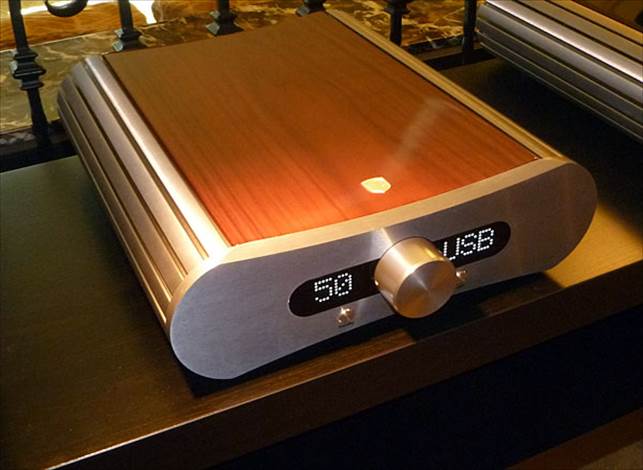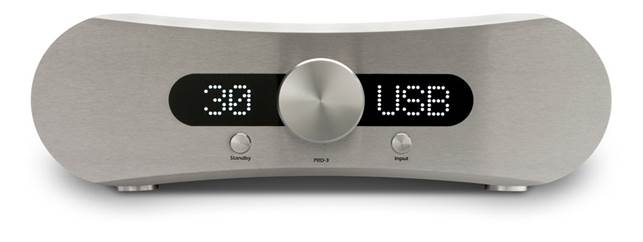A silky smoothness
I began listening to the PRD-3 by using it as a standalone
USB DAC for computer audio playback, presenting it with a barrage of
44.1kHz/16-bit CD rips and high resolution file downloads. First impressions
were extremely positive as I welcomed its evident silky smoothness and finesse,
the Gato DAC dispensing a rich and creamy sound balance full of beauty and
charm. I'm tempted to describe it as ‘valve-like' - especially as it conjured
up memories of the seductively inviting Rogue Audio Cronus Magnum integrated
amp that recently graced my system. But this might give a false impression as
the PRD-3 also appears ballsy and robust thanks to its fulsome bass character.
It's certainly a more opulent and full-flavoured Malbec than
a fresh 'n' crisp Pinot; a luxurious limousine rather than a seat-of-the-pants
sports car. Consequently it worked wonders with chill-step electronica, the
angelic voice of Soundmouse in Phaeleh's ‘Here Comes The Sun' from Tides
[Afterlo AFTRCD1004] sounding deliciously sweet as it floated within the
ethereal soundscape.
The song's synthesized bass line was gratifyingly deep and
wholesome, the Gato's low frequency delivery possessing tangible weight and
power so that the bottom octaves provided a strong foundation for the musical
structure.

The Gato DAC
dispensing a rich and creamy sound balance full of beauty and charm
Chris Jones' ‘God Moves On The Water' from his album
Roadhouses And Automobiles [Stockfisch SFR 357 6027 2] opens with a strong
figure on a bass guitar before harmonics from the six-string leap out from the
image - and the PRD-3 reproduced the bass introduction with tremendous wallop.
Similarly ‘No Sanctuary Here' was delivered with colossal muscle and authority.
All the while the Gato DAC had been hooked up to T+A's
three-box P/A/ PS3000HV pre/power combo with its additional behemoth power
supply unit [HFN Sept '14], driving my towering Townshend Sir Galahad monitors.
The Gato's uncommon civility and lack of aggression was highly appreciated with
‘hot' and forceful rock and pop recordings, especially when increasing the
system's volume to remind my neighbours they too need a good hi-fi system to
enrich their leisure time.
If the PRD-3's rich bass was proving a little ‘thick' for my
system, it would be churlish to fault how deep it actually digs. The rollicking
timpani during the opening passage of Britten's Young Person’s Guide, with the
Kansas City Symphony [Reference Recordings RR-120], rolled out like not-so-distant
thunder, with a low and long reverberation that not so much decayed as
disappeared into subsonic regions. Image scale and solidity were fabulous.

Standby and input
selector buttons sit below the large LED matrix display which flanks the
aluminium rotary volume control. Display of input/sampling rate can be
customised
In use as a preamp
T+A's ‘faster' and more incisive- sounding £1990 DAC 8
converter [HFN Oct '12] has remained in my system for the past couple of years
as a reference marker against which I judge other DACs. It's frankly better
suited to my system than Gato's PRD-3, although not everyone will prefer its
sharper sound.
Indeed, the Gato's lack of aggression will undoubtedly be
appreciated by countless music lovers whose systems need taming. Anyway, I next
hooked up the T+A DAC 8's balanced outputs to the PRD-3's XLR input and used
the Gato solely as a preamplifier to drive T+A's P3000HV power amp.
And guess what? I was greeted with a sound much the same as
when using the Gato as a standalone DAC, the preamplifier's disposition
similarly smooth and calm, confirming that it was the honeyed tonality of the
Gato's analogue stages which were determining its overall sonic character.

With a Xilinx FPGA
handling all digital input processing and housekeeping, Gato Audio also
specifies a legacy 24-bit/192kHz DAC and sample rate converter from Burr-Brown.
Note the local input/output relay switching (orange)
It wasn't only with ‘challenging' modern rock that the Gato
sounded delicious. Its richly-textured personality also brought many vintage
recordings to life. One such was Dusty Springfield's ‘Son Of A Preacher Man'
from Dusty In Memphis [Rhino Deluxe Edition, R2 75580], the full-bodied
delivery of the PRD-3 helping to flesh out a thin and rather distant brass
section accompaniment.
Dusty's delectably sultry voice sounded simply wonderful,
hovering in the image of the characteristically 1960s-style ‘ping-pong' stereo
presentation, while the bass and lead guitars were clearly defined in their
respective recording spaces. Again, the Gato's smooth high frequencies tamed
the splashiness from the drum kit's cymbals. In Memphis of course sounds its
age, but it sure did seem lovely...
Gato's PRD-3 delivers sonic finesse rather than
whip-cracking dynamics, with good soundstaging that's capable of extending way
beyond the plane of your loudspeakers when enjoying fine music productions in
which instruments and voices have been panned ‘believably' amid the spatial
field.
Meanwhile, there's little masking of fine detail via the
PRD-3, even if it does lack a degree of incisiveness and sparkling
true-to-life-realism when reproducing today's finest high-resolution
recordings.
But when you consider its stylish good looks, the immaculate
finish of its casework and its seductively balanced sound quality, it really is
a honey for the money.
|
Specifications
·
Maximum output level (Balanced): 18.1Vrms at 73ohm
·
A-wtd S/N ratio (pre / S/PDIF / USB): 89.7dB / 107.7dB /
107.7dB
·
Distortion (1kHz, 0dBFs/–30dBFs): 0.0027% / 0.0002%
·
Dist. & Noise (20kHz, 0dBFs/–30dBFs): 0.035% / 0.012%
·
Freq. resp. (20Hz-20kHz/45kHz/90kHz): –0.1dB to
–0.04dB/–0.8dB/–2.4dB
·
Digital jitter (48kHz/96kHz/USB): 20psec / 13psec / 20psec
·
Resolution @ –100dB (S/PDIF / USB): ±0.2dB / ±0.2dB
·
Power consumption: 12W (1W Standby)
·
Dimensions (WHD) / Weight: 325x105x420mm / 7kg
|